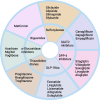Repurposing metabolic regulators: antidiabetic drugs as anticancer agents
- PMID: 39333445
- PMCID: PMC11436690
- DOI: 10.1186/s43556-024-00204-z
Repurposing metabolic regulators: antidiabetic drugs as anticancer agents
Abstract
Drug repurposing in cancer taps into the capabilities of existing drugs, initially designed for other ailments, as potential cancer treatments. It offers several advantages over traditional drug discovery, including reduced costs, reduced development timelines, and a lower risk of adverse effects. However, not all drug classes align seamlessly with a patient's condition or long-term usage. Hence, repurposing of chronically used drugs presents a more attractive option. On the other hand, metabolic reprogramming being an important hallmark of cancer paves the metabolic regulators as possible cancer therapeutics. This review emphasizes the importance and offers current insights into the repurposing of antidiabetic drugs, including metformin, sulfonylureas, sodium-glucose cotransporter 2 (SGLT2) inhibitors, dipeptidyl peptidase 4 (DPP-4) inhibitors, glucagon-like peptide-1 receptor agonists (GLP-1RAs), thiazolidinediones (TZD), and α-glucosidase inhibitors, against various types of cancers. Antidiabetic drugs, regulating metabolic pathways have gained considerable attention in cancer research. The literature reveals a complex relationship between antidiabetic drugs and cancer risk. Among the antidiabetic drugs, metformin may possess anti-cancer properties, potentially reducing cancer cell proliferation, inducing apoptosis, and enhancing cancer cell sensitivity to chemotherapy. However, other antidiabetic drugs have revealed heterogeneous responses. Sulfonylureas and TZDs have not demonstrated consistent anti-cancer activity, while SGLT2 inhibitors and DPP-4 inhibitors have shown some potential benefits. GLP-1RAs have raised concerns due to possible associations with an increased risk of certain cancers. This review highlights that further research is warranted to elucidate the mechanisms underlying the potential anti-cancer effects of these drugs and to establish their efficacy and safety in clinical settings.
Keywords: Antidiabetic drugs; Cancer; Diabetes mellitus; Drug repurposing.
© 2024. The Author(s).
Conflict of interest statement
The authors declare no competing interests.
Figures




References
-
- Klil-Drori AJ, Azoulay L, Pollak MN. Cancer, obesity, diabetes, and antidiabetic drugs: is the fog clearing? Nat Rev Clin Oncol. 2017;14(2):85–99. 10.1038/nrclinonc.2016.120. - PubMed
-
- Ogurtsova K, Guariguata L, Barengo NC, Ruiz PL-D, Sacre JW, Karuranga S, Sun H, Boyko EJ, Magliano DJ. IDF diabetes atlas: global estimates of undiagnosed diabetes in adults for 2021. Diabetes Res Clin Pract. 2022;183:109118. 10.1016/j.diabres.2021.109118. - PubMed
-
- Bray F, Laversanne M, Sung H, Ferlay J, Siegel RL, Soerjomataram I, Jemal A. Global cancer statistics 2022: GLOBOCAN estimates of incidence and mortality worldwide for 36 cancers in 185 countries. CA: Cancer J Clin. 2024;74(3):229–63. 10.3322/caac.21834. - PubMed
Publication types
MeSH terms
Substances
LinkOut - more resources
Full Text Sources
Medical
Miscellaneous
